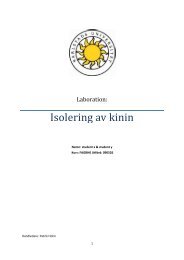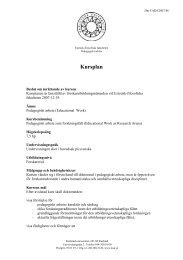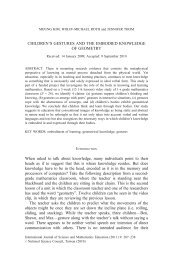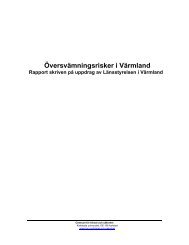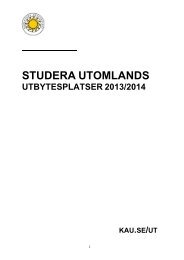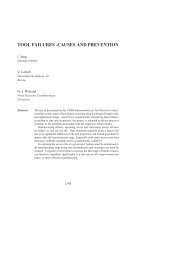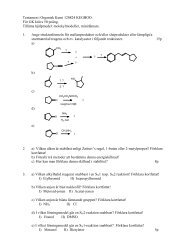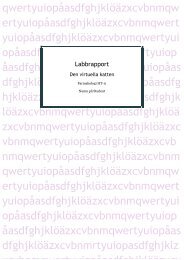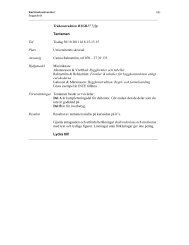Coupled reactions in glycolysis
Coupled reactions in glycolysis
Coupled reactions in glycolysis
You also want an ePaper? Increase the reach of your titles
YUMPU automatically turns print PDFs into web optimized ePapers that Google loves.
<strong>Coupled</strong> <strong>reactions</strong> <strong>in</strong> <strong>glycolysis</strong><br />
1. Background and theory<br />
The aim of this exercise is to illustrate some of the <strong>reactions</strong> of <strong>glycolysis</strong> and how the<br />
thermodynamically unfavourable <strong>reactions</strong> can be driven by coupl<strong>in</strong>g to favourable<br />
<strong>reactions</strong>. In addition, the use of spectrophotometry to follow the formation or<br />
consumption of NADH is demonstrated.<br />
The <strong>reactions</strong> under study are:<br />
step 1 of <strong>glycolysis</strong>:<br />
step 6 of <strong>glycolysis</strong>:<br />
Glyceraldehyde -<br />
phosphate<br />
dehydrogenase<br />
(GAPDH)<br />
Glyceraldehyde - 3 - phosphate + P i<br />
+ NAD + ← ⎯⎯ ⎯⎯ ⎯⎯ ⎯⎯ ⎯⎯ ⎯⎯ →<br />
1,3 bisphosphoglycerate +NADH<br />
€<br />
step 7 of <strong>glycolysis</strong>:
In summary:<br />
The optical spectra of NAD + and NADH are shown <strong>in</strong> figure 1 below. The different<br />
spectra allow the monitor<strong>in</strong>g of the GAPDH reaction where NADH is formed, with<br />
subsequent <strong>in</strong>crease of the absorbance at 340 nm. The other <strong>reactions</strong> are followed<br />
<strong>in</strong>directly from their effect on the equilibrium position of the GAPDH reaction.<br />
If we, for example, start with a NAD + , GAP and phosphate, and <strong>in</strong>itiate the reaction by<br />
the addition of GAPDH, we will observe formation of NADH as the equilibrium is<br />
established. If Mg-ADP and PGK is added at this po<strong>in</strong>t, more NADH will be formed<br />
s<strong>in</strong>ce 1,3-PGA is consumed <strong>in</strong> the PGK reaction. The reaction stops when both equilibria<br />
are established. More details about the reaction mechanism of GAPDH and the<br />
thermodynamics of <strong>glycolysis</strong> <strong>in</strong> Lehn<strong>in</strong>ger , pp. 536 and 553.<br />
Figure 1. Optical spectra of NADH and NAD + . The molar absorptivity<br />
(ext<strong>in</strong>ction coefficient) of NADH at 340 nm is 6.22 x 10 3 M -1 cm -1<br />
(from Lehn<strong>in</strong>ger. P. 517)
2. Materials<br />
2.1 Equipment<br />
Spectrophotometer (preferably a double beam <strong>in</strong>strument) with recorder.<br />
1 ml quartz cuvette<br />
Pipettors<br />
2.2 Chemicals<br />
2.2.1 Solutions to be prepared by the student<br />
100 mM Tris-HCl pH 7.4 conta<strong>in</strong><strong>in</strong>g 0.5 mM EDTA 100 ml<br />
300 mM sodium phosphate buffer, pH 7.4 50 ml<br />
100 mM MgCl 2 (aqueous) 10 ml<br />
2 mM ADP <strong>in</strong> Tris buffer 10 ml<br />
2 mM NAD <strong>in</strong> Tris buffer 10 ml<br />
100 mM glucose (aqueous) 10 ml<br />
0.17 M Sodium arsenate, pH 8.5<br />
Tris buffer: Dissolve the calculated amounts of Tris and Na 2 EDTA <strong>in</strong> about 80 ml water,<br />
adjust pH to 7.4 with 5 M HCl (small additions when pH approaches the desired value)<br />
and dilute to 100 ml.<br />
Phosphate buffer: dissolve the calculated amount of NaH 2 PO 4 <strong>in</strong> 40 ml water and adjust<br />
pH to 7.4 with 5 M NaOH; dilute to 50 ml with water.
2.2.2 Solutions available<br />
about 30 mM D,L-glyceraldehyde phosphate<br />
(note that only the D-form serves as substrate!)<br />
about 70 µM glyceraldehyde phosphate dehydrogenase<br />
about 100 µM hexok<strong>in</strong>ase<br />
about 1 µM phosphoglyceratk<strong>in</strong>as<br />
GAP<br />
GAPDH<br />
HK<br />
PGK<br />
All solutions except the Tris buffer should be kept on ice
3. Procedure<br />
The <strong>reactions</strong> are monitored by the absorbance at 340 nm where NADH absorbs. Prepare<br />
the substrate mixture <strong>in</strong> the cuvette and place it <strong>in</strong> the spectrophotometer. Zero the<br />
<strong>in</strong>strument and start record<strong>in</strong>g. Record the base l<strong>in</strong>e a few m<strong>in</strong>utes, and then make<br />
additions as <strong>in</strong>dicated <strong>in</strong> the description of the experiments. Be careful to allow the<br />
reaction come to equilibrium after each addition (note that this can take up to 20 m<strong>in</strong>);<br />
note however that all additions do not result <strong>in</strong> a reaction. Be careful to mix the contents<br />
of cuvette after each addition. Always use a clean pipette tip to avoid any contam<strong>in</strong>ations<br />
of the reagents.<br />
Experiment 1<br />
As a starter, we <strong>in</strong>vestigate the complete reaction system. Set the <strong>in</strong>strument to a total<br />
record<strong>in</strong>g time of about 30 m<strong>in</strong> and set the scale to use 1 absorbance unit correspond<strong>in</strong>g<br />
full scale.<br />
Substrate<br />
Additions<br />
Tris Buffer 805 µl 1. GAPDH 25µl<br />
NAD 100 µl 2. PGK 10 µl<br />
Phosphate buffer 10 µl 3. HK 10 µl<br />
ADP 10 µl<br />
MgCl 2 50 µl<br />
Glucose 25 µl<br />
GAP 40 µl<br />
Then we change the order of the additions to be sure that the system works accord<strong>in</strong>g to<br />
the description.
Experiment 2<br />
Substrate<br />
Additions<br />
Tris Buffer 950 µl 1. GAPDH 25µl<br />
NAD 100 µl 2. PGK 10 µl<br />
Phosphate buffer 10 µl 3. HK 10 µl<br />
ADP 10 µl 4. Glucose 25 µl<br />
MgCl 2 50 µl<br />
GAP 40 µl<br />
Experiment 3 (change the scale to about 0.2 absorbance units full scale)<br />
Substrate<br />
Additions<br />
Tris Buffer 790 µl 1. GAPDH 25µl<br />
NAD 100 µl 2. PGK 10 µl<br />
Phosphate buffer 10 µl 3. MgCl 2 50 µl<br />
ADP 100 µl<br />
GAP 40 µl<br />
Experiment 4<br />
Substrate<br />
Additions<br />
Tris Buffer 790 µl 1. GAPDH 25µl<br />
NAD 100 µl<br />
Phosphate buffer 10 µl<br />
GAP 40 µl<br />
Arsenate 100 µl
4.<br />
Documentation and report<strong>in</strong>g<br />
All experimental work is to be recorded <strong>in</strong> the laboratory notebook by each student. Each<br />
group submits a summary of the observations <strong>in</strong> experiment 1-4 and a calculation of ∆G o '<br />
for the GAPDH-reaction (compare the result with the literature value <strong>in</strong> Lehr<strong>in</strong>ger<br />
table 14-2). Discuss briefly the effect of arsenate <strong>in</strong> experiment 4.<br />
The submission of a laboratory complete report will be assigned to some groups. The<br />
report should consist of the follow<strong>in</strong>g sections:<br />
- Summary<br />
- Introduction (background and aim with the experiments)<br />
- Materials and methods<br />
- Results<br />
- Discussion. This section should also <strong>in</strong>clude a summary of the results obta<strong>in</strong>ed by<br />
the other groups.



